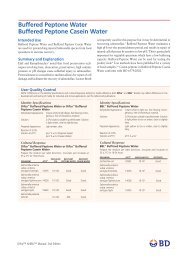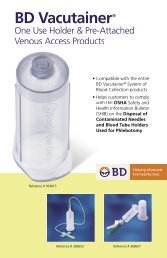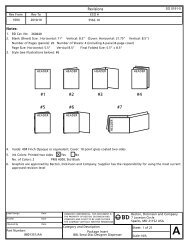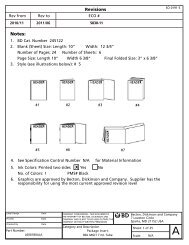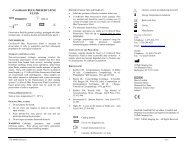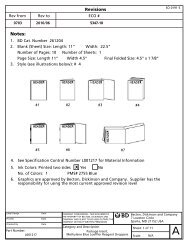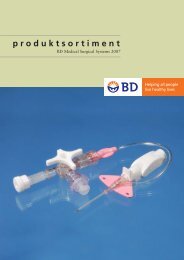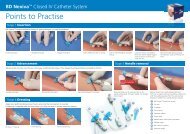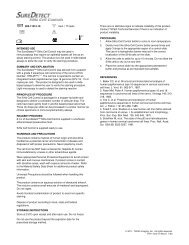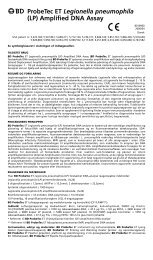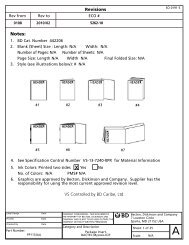Calcofluor White Reagent Droppers - BD
Calcofluor White Reagent Droppers - BD
Calcofluor White Reagent Droppers - BD
You also want an ePaper? Increase the reach of your titles
YUMPU automatically turns print PDFs into web optimized ePapers that Google loves.
<strong>Calcofluor</strong> <strong>White</strong> <strong>Reagent</strong><br />
<strong>Droppers</strong><br />
English: pages 1 – 3 Italiano: pagine 6 – 8<br />
L001206<br />
Français : pages 3 – 4 Español: páginas 8 – 10 2010/06<br />
Deutsch: Seiten 4 – 6<br />
INTENDED USE<br />
<strong>BD</strong> <strong>Calcofluor</strong> <strong>White</strong> <strong>Reagent</strong> <strong>Droppers</strong> are used in the rapid fluorescent microscopic detection<br />
of fungi in direct smears.<br />
SUMMARY AND EXPLANATION<br />
<strong>Calcofluor</strong> white is a nonspecific fluorochrome stain that binds to fungi and, depending upon<br />
the filter system employed, fluoresces either an apple green or blue white color when exposed<br />
to light of the appropriate wavelength. 1 It may be used on fresh, frozen, fixed, paraffinimbedded,<br />
and clinical specimens. 2 It has been reported that calcofluor white can be used in the<br />
detection of parasitic Pneumocystis jiroveci (formerly Pneumocystis carinii) 3 and other<br />
opportunistic fungal organisms in bronchoalveolar lavage (BAL) specimens and aspirates from<br />
immunosuppressed individuals. 4,5<br />
PRINCIPLES OF THE PROCEDURE<br />
<strong>Calcofluor</strong> white is a disodium salt of 4,4’-bis-[4-anilino-bis-diethylamino-5-triazin-2-ylamino]-<br />
2,2’-stilbene-disulfonic acid, a colorless dye that is used in the textile and paper industry as a<br />
whitening agent. It has the ability to bind to β 1-3, β 1-4 polysaccharides (i.e., cellulose and<br />
chitin), and exhibits fluorescence when exposed to long-wavelength ultraviolet and shortwavelength<br />
visible light. It has been used as a biological marker to stain the cell wall of plants,<br />
and is therefore valuable in delineating fungal elements. 6<br />
REAGENTS<br />
<strong>Calcofluor</strong> <strong>White</strong> <strong>Reagent</strong> <strong>Droppers</strong> contain 0.5 mL of a 0.05% solution of calcofluor white in<br />
distilled water.<br />
Warnings and Precautions:<br />
For in vitro Diagnostic Use.<br />
Avoid contact with skin. Rinse thoroughly with water if spilled.<br />
Pathogenic microorganisms, including hepatitis viruses and Human Immunodeficiency Virus,<br />
may be present in clinical specimens. “Standard Precautions” 7-10 and institutional guidelines<br />
should be followed in handling all items contaminated with blood and other body fluids. Prior<br />
to discarding, specimen containers and other contaminated materials must be sterilized by<br />
autoclaving.<br />
Storage Instructions: Store at room temperature 15 – 30°C (59 – 85ºF). Protect from light.<br />
Product Deterioration: This reagent is hermetically sealed in an ampule, which affords<br />
protection of the solution from chemical instability until the expiration date. The staining<br />
solution should be clear with a slight green tint. Do not use if a heavy white precipitate is<br />
evident. Each dropper is good for one day’s use after ampule has been broken. Do not use after<br />
the expiration date.<br />
PROCEDURE<br />
Material Provided: <strong>Calcofluor</strong> <strong>White</strong> <strong>Reagent</strong> <strong>Droppers</strong>. Each dropper contains sufficient<br />
reagent to stain one slide.<br />
Materials Required But Not Provided: Ancillary culture media, reagents, 10% Potassium<br />
Hydroxide <strong>Reagent</strong> Dropper, Cat. No. 261191, quality control organisms, a fluorescent<br />
microscope and other laboratory equipment as required for this procedure.<br />
Test Procedure:<br />
GENERAL SPECIMENS (hair, nails, skin, other tissue, culture, etc.)<br />
1. Slides used should be clean and free of oils and debris.<br />
2. Prepare a smear of the specimen to be stained.<br />
3. Add 1 to 2 drops of a 10% potassium hydroxide solution and gently mix to spread.<br />
4. Hold <strong>Calcofluor</strong> <strong>White</strong> <strong>Reagent</strong> dropper upright and POINT TIP AWAY FROM YOURSELF.<br />
Grasp the middle with thumb and forefinger and squeeze gently to break ampule inside<br />
the dropper. Caution: Break ampule close to its center one time only. Do not manipulate<br />
the dropper any further as the plastic may puncture and injury may occur. Tap the bottom<br />
of the dropper on the tabletop a few times. Invert for convenient drop-by-drop dispensing<br />
of the reagent.<br />
5. Add 1 to 2 drops of <strong>Calcofluor</strong> <strong>White</strong> <strong>Reagent</strong>. Wait for 1 to 2 min.<br />
6. Mount specimen with a cover slip.<br />
7. Using a fluorescent microscope, examine smears initially at 10X, then confirm findings at a<br />
higher magnification.<br />
8. Tissue sections showing fungi can be rinsed in distilled water and restained with periodic<br />
acid-Schiff stain or by the Gomori methenamine silver (GMS) technique. 6<br />
ASPIRATE OR BRONCHOALVEOLAR LAVAGE (BAL) SPECIMENS<br />
1. Slides used should be clean and free of oils and debris.<br />
2. Specimens may be fresh or centrifuged and resuspended to the appropriate concentration<br />
in Phosphate Buffered Saline (PBS), pH 7.4.




